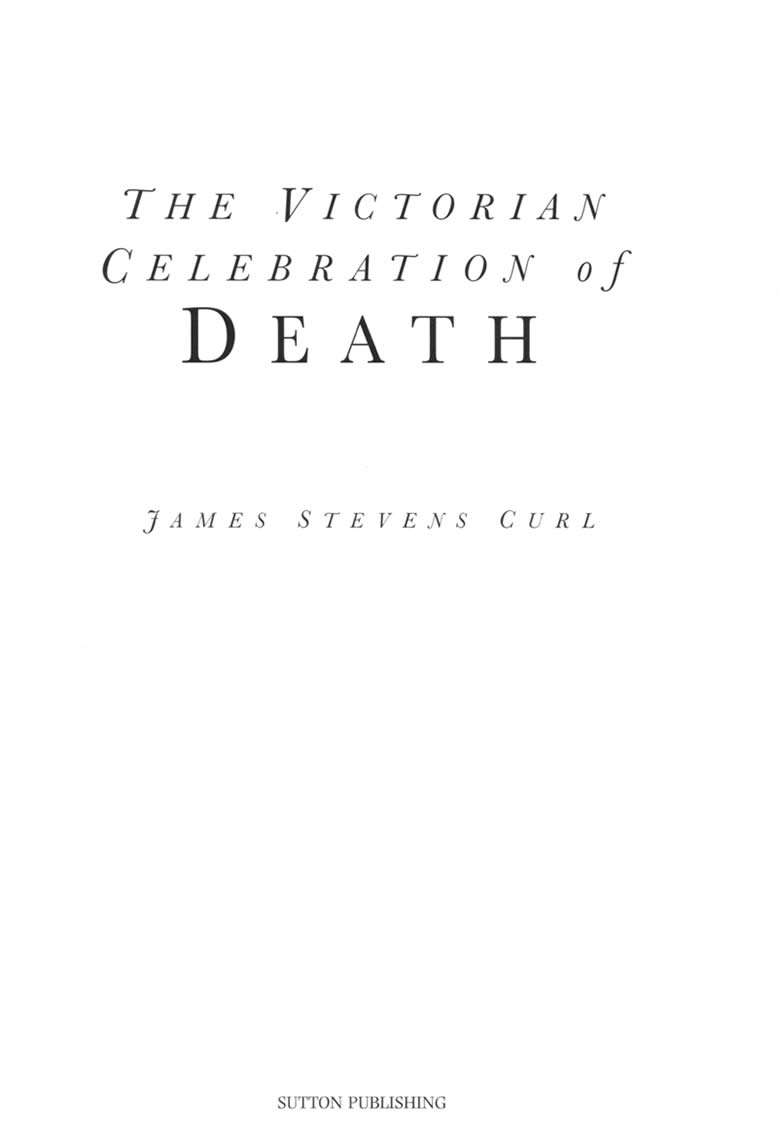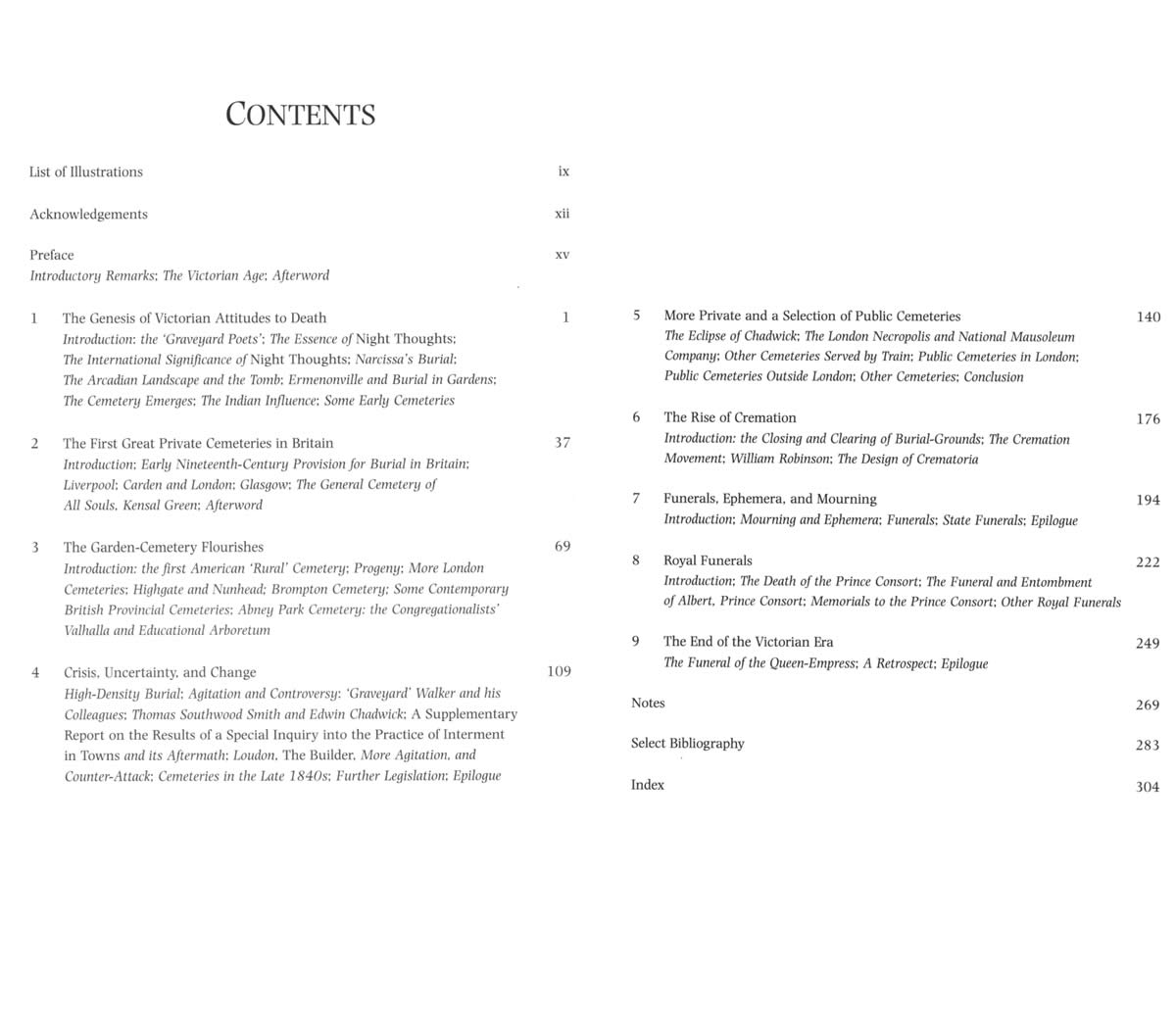The Victorian Celebration of Death

Author : James Stevens Curl
Publisher : Thrupp, Stroud: Sutton Publishing Ltd., 2000 & 2004
ISBN:0-7509-2318-0 (2000 ed.) (hbk)
ISBN:0-7509-3873-0 (2004 ed.) (pbk)
In this illustrated book, much fascinating material has been rescued from undeserved oblivion, and the work fills a genuine gap. From humble working-class exequies to the massive outpourings of grief at the State funerals of Wellington and Queen Victoria herself, the book covers an immense canvas: disposal of the dead as part of the great sanitary reforms of the epoch (though given appropriate expression in cemeteries as works of art); the history of the urban cemeteries with their architecture and landscapes; the ephemera of death and dying (including wreaths, mourning-cards and jewellery, elaborate hearses crowded with ostrich-feather plumes, mourning-dress, and much else); State funerals as national spectacles; and the utilitarian reactions towards the end of the nineteenth century. Widely acclaimed, this volume sheds light on aspects of the 19th century often completely ignored.
This book’s first manifestation was:
The Victorian Celebration of Death (Newton Abbot: David & Charles [Publishers] Ltd., 1972, ISBN: 0-7153-5446-9 [hbk.]).
Reviews
2000 & 2004 edns.
'Curl covers an impressively wide range of topics, masterfully controlling material which could well have become unwieldy. He does not spare us, and nor should he, since they are central to his theme, the almost unbelievable horrors of intramural burial… He describes the rise of the cemetery movement against the background of the urban growth, high mortality rate, and huge demographic changes of Britain in the nineteenth century… The literary side of this huge subject is interestingly handled… quotations which introduce each chapter, and indeed those in the text too, are memorable and apposite, if at times strong stuff… Curl… examines the whole cult of death and bereavement, the trappings of funerals and the ephemera connected with them… (his book) gives rise to many reflections and comparisons on the part of the reader about attitudes to death and bereavement, both then and now.'
'The Victorian Celebration of Death was first published in 1972 and effectively created a new subject for historical research. There had previously been studies of funerary monuments, but there had never been an historical study of the cemetery as an architectural type. Curl having blazed the trail, others... followed... The revised and expanded work has profited from research that has been carried out in the last three decades...'
'When Curl first began writing about cemeteries he was ridiculed as “perverse” and “morbid”, but there is little doubt that today’s more robust, natural attitude to cemeteries is largely due to [his] writing. Curl is one of those rare people who is not only a rigorous historian, but also an enthusiastic and compelling writer. No aspect of death and disposal [is] not covered by Curl.'
'Today [in 2001] there has been a definite shift in perception and with it a dawning acknowledgement of the historical, artistic, and social value of the Victorian culture of commemoration. There are various reasons for this change, but a principal catalyst, particularly for the development of academic interest in the field, was the publication in 1972 of Curl’s [study], the first work of modern scholarship to recognise the importance of nineteenth-century cemeteries and their monuments, and to protest against the ignorant indifference that was condemning them to neglect and destruction. Authoritative and scholarly, The Victorian Celebration of Death is also an intensely personal book… shot through with the strong and inspiring sense of a scholar and campaigner who continues passionately to argue and fight for what he believes in. While Curl welcomes the evidence of a change in attitudes towards historic cemeteries, a change for which he can take much credit, he still rages – quite rightly – against ignorant dismissiveness and the stupid destruction to which it can often lead. But now his anger embraces a wider front than thirty years ago. In… utilitarian anonymity… he reads a terrible indifference, a denial of all those yesterdays from which we build our very sense of identity. “We are to be set adrift without the anchor of any communal memory, any history, anything that links us with our ancestors or with times that are gone”. That is as eloquent as it is bleak, and it encapsulates much of the book’s running attack on the banality and superficiality of contemporary society… Curl’s critique of the modern should be listened to. For the way in which a society habitually regards the dead implies a great deal about how it treats the living.'
'Curl’s beautifully illustrated book treats the whole question of the Victorian commemoration of death with wit and elegance. He does, in fact, do much more, analysing “the great black cornucopia of Victorian agony and the terrific paraphernalia of the Last Act” in considerable detail.'
'In this fascinating book … Curl’s starting premise is the romantic, literary, Arcadian view expressed in the writings of Thomas Gray, Robert Blair, and Edward Young… Curl does not neglect, however, the more prosaic aspects of the state of burial of the dead in Victorian Britain… One of the best features of The Victorian Celebration is its wonderful survey of state funerals… Curl examines all the details… He includes fascinating accounts of some of the more eccentric and esoteric aspects of the subject.'
'This wonderful book on the 19th-century iconography of death… is a masterpiece… and more than vindicates Curl’s status as pioneer of the dark art of funerary studies. Every page of this book is a treat – “gorgeous grief” indeed.'
'Fascinating, well researched, and easily read, this book, about a subject from which none can escape, is a must.'
'… a valuable contribution to a proper understanding of the complexities of the needs of social reformers and the greed of private entrepreneurs… This erudite publication must find its way into the libraries of universities, colleges, genealogists, and interested general readers.'




 LinkedIn
LinkedIn  Wikipedia
Wikipedia